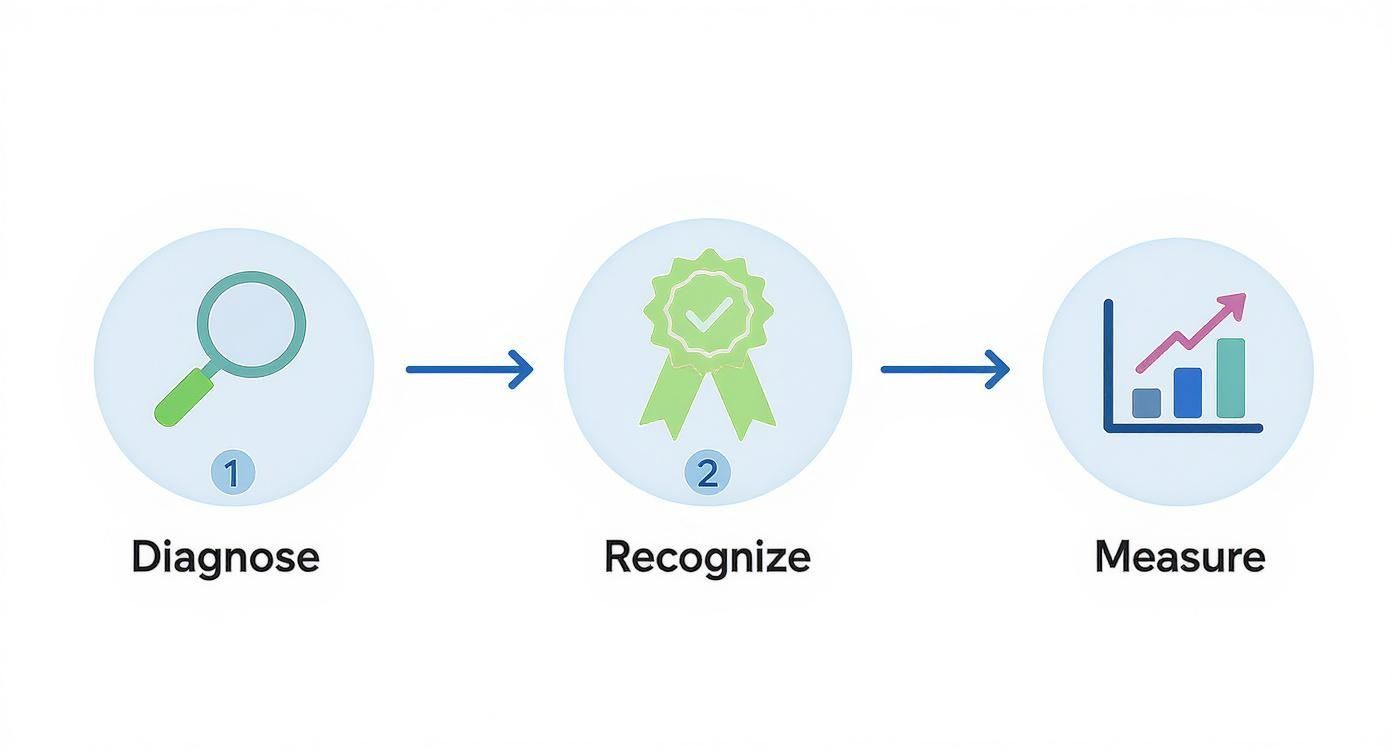Improving your company culture isn’t about grand, sweeping gestures. It’s about the small, consistent, and meaningful things you do every single day. The real work begins with a simple, powerful principle: build a foundation of psychological safety and genuine employee recognition. This guide is your practical roadmap to creating a culture where people truly feel valued, safe, and motivated to do their best work.
Table of Contents
Your Starting Point for a Better Workplace Culture
A great workplace culture isn’t defined by flashy perks like free lunches or unlimited vacation. While those benefits are nice, they don’t get to the heart of what makes people want to stay and contribute. The real substance is in how employees are valued, trusted, and respected daily.
It all comes down to creating an environment where people feel seen and heard.
Think of it this way: culture is just the sum of all your everyday interactions. It’s how leaders communicate, how teams work together, and how you celebrate accomplishments—both big and small. Let these fundamentals slide, and you’re paving the road to disengagement and burnout.
The Power of Recognition and Care
If you’re looking for a place to start, focus on team recognition. It’s a powerful catalyst for change because it reinforces the exact behaviors you want to see while making people feel like their work actually matters. The importance of team recognition cannot be overstated; it’s the most direct way to show employees that their contributions are seen and valued. When praise is specific, public, and timely, it connects an individual’s effort directly to the team’s goals, building a real sense of pride and belonging.
For example, a generic “good job” is forgettable. But what if a manager says, “Sarah, the way you proactively organized the project files saved the team hours of confusion. That attention to detail is exactly what we need.” That kind of specific feedback validates the effort and shows everyone else what excellence looks like.
A culture of care isn’t just a feel-good initiative; it’s a strategic imperative. When people feel supported, their loyalty, engagement, and overall performance improve dramatically, creating a positive feedback loop that benefits the entire organization.
The data tells a clear story. Employees who feel genuinely cared for by their organizations are 84% less likely to experience burnout, 30% less likely to leave their jobs, and a staggering 12 times more likely to report high levels of engagement. This isn’t about just being nice; it’s about building a workplace where people can thrive.
Four Pillars of a Thriving Culture
To get started, you need to build on four foundational pillars. These aren’t just buzzwords; they are the core components that work together to create an ecosystem of trust, respect, and shared purpose. A great culture doesn’t happen by accident—it’s designed with intention.
This table breaks down what those pillars are and how to put them into action.
Four Pillars of a Thriving Workplace Culture
| Pillar | Key Action | Expected Impact |
|---|---|---|
| Psychological Safety | Encourage open dialogue, normalize asking for help, and ensure leaders model vulnerability. | Employees feel safe to take risks, share ideas, and admit mistakes without fear of blame. |
| Consistent Recognition | Create public and private channels for timely, specific praise. Celebrate both big wins and small efforts. | Boosts morale, reinforces desired behaviors, and makes individuals feel valued and seen. |
| Transparent Communication | Share information about company goals, challenges, and decisions openly and honestly. | Builds trust, reduces uncertainty, and helps employees feel connected to the bigger picture. |
| Growth & Development | Invest in training, mentorship, and clear career paths. Support employees in acquiring new skills. | Increases employee retention, improves performance, and shows the company is invested in its people. |
By focusing on these four areas, you create a self-reinforcing system where people feel supported and motivated. If you want to dig deeper into establishing a thriving work environment, you can find more insights on how to foster a positive workplace culture.
How to Accurately Diagnose Your Current Culture
Before you can start improving your workplace culture, you need a brutally honest assessment of where you are right now. Jumping into solutions without a proper diagnosis is like a doctor prescribing medicine without knowing the illness—it’s a shot in the dark that can sometimes make things worse.
A true culture audit goes far beyond the generic annual employee survey. It’s about digging deeper to understand the unspoken rules, the subtle behaviors, and the day-to-day realities your team experiences. The goal here is to move past surface-level complaints and uncover the root causes of things like disengagement, communication breakdowns, or a lack of trust.
Moving Beyond Surface-Level Surveys
Annual engagement surveys have their place, but let’s be real: they’re often a lagging indicator, telling you about problems that have been brewing for months. To get an accurate, real-time pulse on your culture, you need to combine a few different feedback methods. This approach ensures you capture both the broad trends and the nuanced, personal experiences that truly define how it feels to work at your company.
A solid culture audit blends hard data with human stories. Think of it as pairing a wide-angle lens with a microscope; you need both to see the complete picture.
Here are the key components I’ve seen work best:
- Anonymous Pulse Surveys: These are quick, frequent check-ins—think weekly or bi-weekly—that ask just a few targeted questions. For a practical example, you could ask, “On a scale of 1-5, how supported did you feel by your manager this week?” This is fantastic for tracking sentiment over time and spotting dips before they become full-blown crises.
- Small-Group Listening Sessions: Get 4-6 employees in a room for a confidential, facilitated conversation. This intimate setting encourages the kind of honest dialogue you’ll never get in a big town hall or through an anonymous form.
- One-on-One ‘Stay Interviews’: Forget exit interviews. By the time someone is leaving, it’s too late. Stay interviews proactively ask your best people why they stay. For example, ask, “What was the best day you had at work in the last month, and what made it great?” This gives you invaluable insight into what you’re doing right and what’s most important to your top performers.
This visual illustrates how a proper diagnosis is the essential first step, leading directly to meaningful recognition and, ultimately, measuring your impact.

The infographic presents a straightforward yet powerful sequence. It all starts with a clear, unflinching look at your current state.
Asking Questions That Uncover the Truth
The quality of your diagnosis ultimately depends on the quality of your questions. If you ask vague, leading questions, you’ll get vague, unhelpful answers. You need to ask questions that prompt people to share specific stories and examples.
Instead of asking, “Are you happy working here?” which invites a simple yes or no, try asking something more pointed.
“When was the last time you felt truly recognized for your work?”
This question doesn’t just ask about happiness; it probes for a specific experience tied to value and appreciation—two absolute pillars of a healthy culture. This slight shift in how you ask questions uncovers incredibly actionable information.
If several employees can’t recall a recent moment of recognition, you’ve just pinpointed a critical gap. That insight is far more valuable than a generic 8/10 satisfaction score.
Identifying Patterns and Root Causes
Once you’ve gathered all this feedback from surveys, listening sessions, and interviews, the real work begins. Your job is to sift through everything and start connecting the dots. Are communication bottlenecks a recurring theme? Do people in different departments feel that leadership isn’t being transparent? Is there a widespread feeling that great work goes completely unnoticed?
Look for the connections. For instance, a low pulse survey score on “psychological safety” might line up perfectly with feedback from a listening session about people feeling afraid to admit mistakes. That’s not an isolated incident; it points to a systemic issue.
By focusing on these patterns, you can create a clear, data-informed starting point for change. This isn’t about placing blame. It’s about understanding the system so you can identify the right levers to pull and make a meaningful difference, ultimately improving workplace culture for everyone.
Designing Recognition Programs People Actually Value
A thriving culture runs on meaningful recognition. But if it’s not authentic and consistent, the engine stalls. The importance of recognition lies in its ability to make appreciation a visible and tangible part of the work experience. Once you’ve taken a hard look at your current environment, it’s time to build recognition rituals that actually stick—rituals that become part of your company’s DNA. This isn’t about flashy, expensive gifts; it’s about creating systems that make feeling valued an everyday experience.
The best programs I’ve seen are multi-layered. They celebrate everything, from the huge project launch to the small, daily wins that often go unnoticed. A fantastic place to start is by creating an accessible, public space for praise. This simple shift moves recognition from a private, top-down formality to a visible, community-driven habit.

That visibility is everything. When praise is public, it does more than just reward one person. It shows the entire team what success looks like in action. It’s a subtle but powerful way to reinforce your company values, highlighting the very behaviors you want everyone to emulate.
Creating a Ritual with Peer-to-Peer Recognition
Let’s be honest: some of the most powerful recognition comes from the person sitting next to you, not just your manager. Peer-to-peer praise feels incredibly genuine because it comes from someone who’s right there in the trenches with you. It validates the hard work and collaborative spirit that managers don’t always get to see firsthand.
The easiest way to get this off the ground? Weave it into the tools your team already uses every single day, like Slack.
Create a dedicated public channel—something like #props, #shoutouts, or #wins. This gives appreciation a home, making it an intentional and visible part of the workday. Encourage everyone, from the newest intern to the CEO, to jump in and share specific moments of gratitude. If you need some inspiration, check out these real-world peer-to-peer recognition examples to see how other companies are doing it.
Here’s a tip from experience: Don’t just create the channel and walk away. Leaders have to go first. When a manager consistently gives public props in the channel, it gives everyone else the green light and encouragement to do the same.
This kind of immediate, in-the-moment recognition hits so much harder than a delayed “thank you” in a performance review. It captures the energy of the moment and reinforces great work instantly.
Moving Beyond “Good Job” with Specific Praise
The line between forgettable praise and meaningful recognition is drawn in the details. A generic “good job” is nice, sure, but it’s hollow. It doesn’t tell the person what they did well or why it mattered. To make an impact, you must be specific.
This is a skill that can be learned and coached. The goal is to connect a person’s action directly to a positive outcome or a company value. Suddenly, feedback transforms from a simple compliment into a decisive coaching moment.
Here’s how you can reframe generic praise into something with real substance:
| Instead of This… | Try This… | Why It Works |
|---|---|---|
| “Good job on the presentation.” | “I was so impressed with how you handled the tough questions after your presentation. Your calm and data-driven answers built a lot of trust with the client.” | It pinpoints the specific skill (handling questions) and explains the positive business impact (built client trust). |
| “Thanks for your help.” | “Thank you for jumping in to help debug that issue yesterday, Alex. We were stuck, and your fresh perspective helped us find the solution in under an hour.” | It acknowledges the specific contribution (debugging), highlights collaboration, and even quantifies the result (solved in under an hour). |
| “You’re a great team player.” | “Maria, I really appreciate you creating that detailed onboarding guide for our new hire. It was incredibly proactive and demonstrates our company value of ‘Lift Others Up’.” | It ties the action (creating a guide) directly to a core company value, reinforcing the culture you want to build. |
That level of specificity shows you’re actually paying attention. It communicates that their unique contribution was seen, understood, and genuinely valued. These are the kinds of interactions that build loyalty and inspire people to go the extra mile.
Structuring Recognition for Broader Impact
While peer-to-peer shoutouts are the lifeblood of daily morale, a truly well-rounded program also needs more structured, formal recognition. This layer ensures you’re celebrating larger achievements and consistently reinforcing your core values in a more official capacity.
Here are a few ideas you can put into practice right away:
- Value-Based Monthly Awards: Create awards that are explicitly tied to your company values. Think “The Customer Obsession Award” or “The Innovation Champion.” Solicit nominations from across the company and announce the winner at your monthly all-hands meeting.
- Celebrating “Quiet” Contributions: Not all impact is loud. I love the idea of a “Behind the Scenes Hero” award to recognize people who do the essential, often invisible work that keeps the wheels turning—like meticulously maintaining documentation or organizing team resources.
- Project Milestone Celebrations: When a team finally ships a major project, don’t just rush to the next one. Pause and celebrate. It could be a team lunch, a special feature in the company newsletter, or a heartfelt thank you from a senior leader highlighting the project’s success.
The trick is to create a diverse ecosystem of recognition. When you combine informal, daily praise with more formal, periodic awards, you ensure that everyone, regardless of their role or personality, has an opportunity to be seen. That balanced approach is what builds a culture where every single person feels appreciated and motivated to do their best work.
Measuring the Real Impact of Your Culture Initiatives
If you can’t measure your culture work, you can’t prove its value. To get and keep leadership on board, you have to draw a straight line from your recognition programs to real business outcomes. This means looking beyond simple satisfaction scores and focusing on the metrics that matter to the C-suite.
Demonstrating the ROI on these efforts is how you shift culture from a “nice-to-have” to a core business strategy. When you can show how a more engaged team leads directly to lower turnover and higher productivity, you’re speaking a language every leader understands.

This data-driven approach is your best friend. It gives you undeniable proof of what’s working, what’s not, and where to focus your energy next.
Key Performance Indicators for Culture
To get a full picture of your culture’s health, you need a smart mix of leading and lagging indicators. Leading indicators are your early-warning system, giving you a glimpse into employee sentiment. Lagging indicators, on the other hand, show you the results of past actions.
Here are the essential metrics I always recommend tracking:
- Employee Net Promoter Score (eNPS): It’s a beautifully simple metric. A single question—“On a scale of 0-10, how likely are you to recommend this company as a great place to work?”—gives you a powerful pulse check on overall loyalty.
- Voluntary Turnover Rate: This is a critical lagging indicator. A high number of people choosing to leave is one of the loudest signals of a culture problem. Tracking this month-over-month is non-negotiable.
- Absenteeism Rate: Seeing a spike in unplanned absences? That’s often a sign of burnout or disengagement bubbling under the surface. It’s an early warning you can act on.
- Recognition Frequency: How often are people actually giving praise? Tools like AsanteBot can give you hard data on this, showing whether that new recognition ritual you launched is getting any traction.
When you start combining these, you can tell a powerful story. For instance, you might see your eNPS score jump a few weeks after launching a peer recognition program, followed by a dip in voluntary turnover the next quarter. That’s the kind of cause-and-effect that gets attention.
Using Pulse Surveys for Real-Time Feedback
Let’s be honest: annual surveys are too slow. By the time you get the data, it’s already out of date. To truly understand how your initiatives are being received, you need to gather feedback in the moment.
This is where lightweight pulse surveys are a game-changer. These are short, targeted questionnaires—just 2-5 questions—sent out regularly, like weekly or bi-weekly. They let you check in on specific topics without creating survey fatigue.
Imagine you just launched a new recognition ritual in Slack. You could send a pulse survey the following week with one simple question: “Did you feel your contributions were seen and valued this week?” This gives you immediate, actionable feedback on whether the program is actually working.
This approach lets you iterate fast. If you notice a dip in positive responses, you can adjust the program immediately instead of waiting a year to discover it was a flop.
Connecting Culture to Business Outcomes
The end goal is to show how a healthier workplace culture directly impacts the bottom line. This is where you connect your people metrics with complex business data.
The link is undeniable. A Gallup global workplace report found that only 30% of employees feel engaged at work. Yet, organizations with highly engaged teams see 23% higher profitability and between 21% and 51% lower turnover. It makes sense—disengaged employees are 56% more likely to be job hunting. You can explore more shocking workplace culture statistics to see just how deep the connection goes.
Start by building a simple dashboard that visualizes these connections. You don’t need a fancy analytics tool; a basic spreadsheet can work wonders.
Sample Dashboard Metrics
| Culture Metric | Corresponding Business Metric | What It Tells You |
|---|---|---|
| eNPS Score | Customer Satisfaction (CSAT) | Happy employees often lead to happier customers. |
| Voluntary Turnover | Cost-to-Hire | Lower turnover directly reduces recruitment expenses. |
| Engagement Scores | Team Productivity / Sales Targets | Engaged teams are more productive and hit their goals. |
By presenting data this way, you build a compelling narrative. You’re no longer just talking about feelings; you’re talking about driving measurable business results. This is how you prove your impact and get the resources you need to keep going.
Keeping the Momentum Going for the Long Haul
Launching a new recognition program is one thing. The initial buzz is great, but the real work begins when that early excitement starts to fade. The truth is, building a better workplace culture isn’t a project with a neat finish line; it’s a commitment that has to be woven into the fabric of your company, every single day.
To keep that momentum, you have to think of your culture as a living, breathing thing. It needs consistent care and attention to grow. It will shift as your company evolves, and your approach needs to be just as dynamic.
Find and Empower Your Culture Champions
Let’s be realistic: you can’t do this alone. And you shouldn’t have to. The single most effective way I’ve seen to keep culture initiatives thriving is to identify and empower ‘Culture Champions’ across the company. These people often aren’t in formal leadership roles. They’re the well-respected, influential team members who already embody the values you want to promote.
Think about the people others naturally turn to for advice, the ones who genuinely care about making the workplace better. By giving them a formal role as a champion, you’re not just giving them a title; you’re giving them a platform to amplify the positive changes you’re trying to make.
- Who are they? They’re the natural connectors, the go-to problem solvers, and the folks you already see giving shoutouts without being asked.
- What do they do? They can be your partners in onboarding new hires, helping run feedback sessions, and acting as your eyes and ears on the ground to spot issues before they blow up. For example, a Culture Champion might notice that the engineering team is feeling burnt out and suggest a virtual game afternoon to recharge.
- How do you support them? Give them a small budget for team-building events. Let them be the first to know about new culture plans. Most importantly, meet with them regularly to hear what they’re seeing and hearing. If they need some fresh ideas, this list of virtual team-building activities is a great starting point.
When you spread out the ownership of culture, it becomes far more resilient and stops being dependent on just one person or the HR team.
Keeping Your Recognition Program Fresh
Even the most well-designed recognition program can start to feel a bit stale over time. People can get what I call ‘praise fatigue’—when recognition becomes so routine that it loses its meaning. The importance of keeping recognition fresh is that it ensures appreciation always feels genuine and impactful, rather than like a box-ticking exercise. Your job is to keep things interesting and find new ways to celebrate each other.
You can’t just set up a #props channel and hope for the best. You have to proactively feed it with energy and creativity to keep people engaged.
A great workplace culture is a garden, not a building. You can’t just construct it and walk away; it needs constant watering, weeding, and attention to thrive through every season.
Here are a few practical ways to keep your recognition rituals from feeling tired:
- Celebrate the Program Itself: Did your team just share its 1,000th piece of recognition? That’s a huge win! Announce it at the next all-hands meeting and celebrate what you’ve all built together.
- Spotlight Great Examples: Don’t let amazing shoutouts get lost in the Slack scroll. Each month, pull out a few of the best ones and feature them in a company-wide newsletter. Be sure to connect the praise directly back to a company value to show everyone what it looks like in action.
- Run Themed Recognition Days: Try dedicating a week to a specific company value. For example, a “Customer Obsession Week” could encourage everyone to look for and share examples of colleagues going the extra mile for a client.
- Rotate Award Ownership: If you have a monthly “Value Champion” award, don’t have it come from the same committee every time. Let different teams or your Culture Champions take a turn selecting the winner. It creates more buy-in and brings a fresh perspective.
This kind of constant evolution is what keeps your program from feeling like another corporate checklist. It ensures it remains a vibrant, authentic part of how you work.
Build a Continuous Feedback Loop
The final piece of this puzzle is creating a way to constantly listen and adapt. Your culture strategy can’t be a document you write once a year and stick in a drawer. It has to be a responsive system that allows you to check in on your goals, look at the data, and tweak your approach as you go.
This isn’t about launching another dreaded annual survey. It’s about opening up smaller, more frequent channels for feedback that allow you to make quick adjustments.
Try setting up a quarterly “Culture Review” meeting with your champions and key leaders. Use that time to review your metrics, talk about the qualitative feedback you’re hearing from the team, and decide on one or two small experiments to run over the next quarter. For instance, if feedback shows people feel meetings are draining, a practical experiment could be to trial “no-meeting Wednesdays” for a month and then survey the team on its impact.
Inevitably, even the best initiatives will hit a snag. When momentum slows, it’s about course-correcting, not giving up. The same principles for getting personal habits back on track apply here, and there are some great strategies for getting back on track that can offer valuable perspective.
This disciplined, agile approach is what will ensure your work remains relevant and impactful. By staying plugged into the needs of your people and the health of the organization, you’ll build a culture that isn’t just great today, but is built to last.
Your Workplace Culture Questions, Answered
Even with the best game plan, you’re bound to hit a few roadblocks when you start intentionally shaping your company culture. I’ve seen leaders grapple with the same kinds of questions time and time again. Let’s tackle some of the most common ones head-on.
What’s the Single Best Place to Start Improving Our Culture?
If you’sre looking for the one thing that will give you the most bang for your buck, it’s consistent, visible, and specific team recognition.
The importance of starting with recognition is its immediate impact and positive ripple effect. Other crucial elements like psychological safety or transparent communication are absolutely vital, but they can be complex and slow to build. Recognition, on the other hand, is a powerful catalyst that immediately reinforces the exact behaviors you want to see more of.
It’s an action you can take right now. You don’t need a massive budget or to roll out a complicated new system. A manager can give detailed, public praise in a team meeting this afternoon. You could launch a dedicated Slack channel like a #kudos or #props channel in the next five minutes. Starting with recognition delivers quick wins, gives morale an almost instant shot in the arm, and builds positive momentum that makes those bigger culture projects feel way less daunting.
How Do I Deal with People Who Resist Culture Changes?
Resistance is normal. Expect it. When people push back, the trick is to meet it with curiosity, not force. Most of the time, resistance isn’t about being stubborn; it’s rooted in something deeper—a fear of the unknown, skepticism from watching past initiatives fizzle out, or a genuine belief that the old way was better.
First, just listen. Pull resistant folks aside for a one-on-one chat. Try asking something open-ended, like, “I get the sense you have some reservations about this new recognition program. I’d love to hear your take on it.” This simple act of validating their perspective can immediately lower their defenses.
Next, lean on your champions. Those influential, respected team members who are already excited about the changes are your secret weapon. Peer-to-peer influence is often far more powerful than any memo from leadership. When a trusted colleague gets behind a change, skeptics start to pay attention.
A common mistake is trying to win over everyone at once. Instead, pour your energy into the people who are already on board and empower them. Their success stories and positive attitudes will create the social proof that eventually pulls the others along.
Remember, consistent action is your most persuasive argument. When resistors see the positive results for themselves—like projects running smoother or a more supportive vibe on the team—most will eventually get on board.
How Often Should We Actually Measure Morale?
That big annual engagement survey? It’s a relic. If you wait a whole year for feedback, you’re always playing catch-up. To get a real-time pulse on your team and see if your efforts are actually working, you need a more frequent, lightweight approach.
A balanced cadence is the way to go:
- Weekly or Bi-Weekly Pulse Checks: These are super short, maybe 1-3 quick questions. They’re perfect for getting instant feedback right after you launch something new or during a big project. A practical example is sending a weekly Slack poll asking, “How would you rate your workload this week: 1 (light) to 5 (overwhelming)?”
- Quarterly Deep Dives: Every quarter, send out a slightly longer survey (5-10 questions) to track your core metrics like eNPS or how people feel about your company values. This helps you spot trends without overwhelming everyone.
- Continuous Listening: The numbers only tell half the story. You have to supplement surveys with the rich, qualitative data you get from one-on-ones, skip-levels, and “stay interviews.” This is where you find the why behind the data.
This rhythm creates a continuous feedback loop, letting you be proactive instead of reactive. It turns measurement from a dreaded annual event into an ongoing, collaborative conversation about making work better for everyone.
Ready to make team recognition an effortless, daily habit? AsanteBot integrates directly into Slack to help you build a vibrant culture of appreciation. Celebrate wins, reinforce values, and get real data on team morale, all within the platform your team already loves.
Start building a stronger culture in minutes with AsanteBot.




